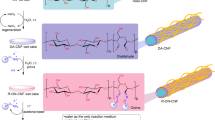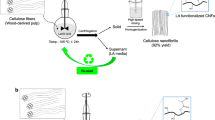Abstract
Produced from plant renewable resources, cellulose nanofibres are an emerging class of sustainable materials with favourable mechanical properties. Once carboxylated, they can be used even more widely thanks to the possibility of surface chemical modifications. However, the current fabrication processes for carboxylated cellulose nanofibres (C-CNFs) either require harsh reaction conditions or severely impair the high aspect ratio of products, resulting in low yields, environmental impacts and poor practical value. Here we address these limitations by using a hydrated multi-carboxylic acid deep eutectic solvent comprised of only choline chloride, citric acid and water to produce ultrafine and fairly long C-CNFs. The resultant C-CNFs possess fine diameters of ~3.4 nm, high aspect ratios up to 2,500, a high carboxyl content of 1.5 mmol g−1 and a high mass yield of 90.12%. Superior stability of the C-CNFs suspensions even at high concentrations allows for easy storage, transportation, processing and utilization. Moreover, the solvent exhibits a tenfold increase in its reusability, thereby highlighting its recyclability and economic viability. We further show large-scale production of C-CNFs for preparing large-area, high-performance structural materials. These unique advantages open a new avenue to the production of functional C-CNFs at an industry compatible scale.
This is a preview of subscription content, access via your institution
Access options
Access Nature and 54 other Nature Portfolio journals
Get Nature+, our best-value online-access subscription
$29.99 / 30 days
cancel any time
Subscribe to this journal
Receive 12 digital issues and online access to articles
$119.00 per year
only $9.92 per issue
Buy this article
- Purchase on Springer Link
- Instant access to full article PDF
Prices may be subject to local taxes which are calculated during checkout






Similar content being viewed by others
Data availability
The data supporting the findings are provided within this article and its Supplementary Information and are available from the corresponding authors on reasonable request.
References
Tardy, B. L. et al. Advancing bio-based materials for sustainable solutions to food packaging. Nat. Sustain. 6, 360–367 (2023).
Ling, S., Kaplan, D. L. & Buehler, M. J. Nanofibrils in nature and materials engineering. Nat. Rev. Mater. 3, 18016 (2018).
Guan, Q. F. et al. Lightweight, tough, and sustainable cellulose nanofiber-derived bulk structural materials with low thermal expansion coefficient. Sci. Adv. 6, eaaz1114 (2020).
Li, Z. et al. Sustainable high-strength macrofibres extracted from natural bamboo. Nat. Sustain. 5, 235–244 (2022).
Fang, Z. et al. Critical role of degree of polymerization of cellulose in super-strong nanocellulose films. Matter 2, 1000–1014 (2020).
Cheng, W. et al. Sustainable cellulose and its derivatives for promising biomedical applications. Prog. Mater. Sci. 138, 101152 (2023).
Jiang, G. et al. A scalable bacterial cellulose ionogel for multisensory electronic skin. Research 2022, 9814767 (2022).
Su, Z. et al. Designed biomass materials for ‘green’ electronics: a review of materials, fabrications, devices, and perspectives. Prog. Mater. Sci. 125, 100917 (2022).
Wang, R., Chen, L., Zhu, J. Y. & Yang, R. Tailored and integrated production of carboxylated cellulose nanocrystals (CNC) with nanofibrils (CNF) through maleic acid hydrolysis. ChemNanoMat 3, 328–335 (2017).
Chen, L., Zhu, J. Y., Baez, C., Kitin, P. & Elder, T. Highly thermal-stable and functional cellulose nanocrystals and nanofibrils produced using fully recyclable organic acids. Green. Chem. 18, 3835–3843 (2016).
Isogai, A., Hänninen, T., Fujisawa, S. & Saito, T. Catalytic oxidation of cellulose with nitroxyl radicals under aqueous conditions. Prog. Polym. Sci. 86, 122–148 (2018).
Meng, J. et al. Recyclable nanocellulose-confined palladium nanoparticles with enhanced room-temperature catalytic activity and chemoselectivity. Sci. China Mater. 64, 621–630 (2021).
Chu, Y., Sun, Y., Wu, W. & Xiao, H. Dispersion properties of nanocellulose: a review. Carbohydr. Polym. 250, 116892 (2020).
Thomas, B. et al. Nanocellulose, a versatile green platform: from biosources to materials and their applications. Chem. Rev. 118, 11575–11625 (2018).
Isogai, A., Saito, T. & Fukuzumi, H. TEMPO-oxidized cellulose nanofibers. Nanoscale 3, 71–85 (2011).
Tsuchiya, H. et al. Cellulose nanofiber composite polymeric materials with reversible and movable cross-links and evaluation of their mechanical properties. ACS Appl. Polym. Mater. 4, 403–412 (2021).
Beaumont, M. et al. Assembling native elementary cellulose nanofibrils via a reversible and regioselective surface functionalization. J. Am. Chem. Soc. 143, 17040–17046 (2021).
Ji, H. et al. Strategy towards one-step preparation of carboxylic cellulose nanocrystals and nanofibrils with high yield, carboxylation and highly stable dispersibility using innocuous citric acid. Green Chem. 21, 1956–1964 (2019).
Spinella, S. et al. Concurrent cellulose hydrolysis and esterification to prepare a surface-modified cellulose nanocrystal decorated with carboxylic acid moieties. ACS Sustain. Chem. Eng. 4, 1538–1550 (2016).
Cui, X., Honda, T., Asoh, T.-A. & Uyama, H. Cellulose modified by citric acid reinforced polypropylene resin as fillers. Carbohydr. Polym. 230, 115662 (2020).
Yang, C. Q. & Wang, X. Formation of five-membered cyclic anhydride intermediates by polycarboxylic acids: thermal analysis and Fourier transform infrared spectroscopy. J. Appl. Polym. Sci. 70, 2711–2718 (1998).
Shinoda, R., Saito, T., Okita, Y. & Isogai, A. Relationship between length and degree of polymerization of TEMPO-oxidized cellulose nanofibrils. Biomacromolecules 13, 842–849 (2012).
Saito, T., Kimura, S., Nishiyama, Y. & Isogai, A. Cellulose nanofibers prepared by TEMPO-mediated oxidation of native cellulose. Biomacromolecules 8, 2485–2491 (2007).
Zhu, L. et al. Shapeable fibrous aerogels of metal–organic-frameworks templated with nanocellulose for rapid and large-capacity adsorption. ACS Nano 12, 4462–4468 (2018).
Rietzler, B. & Ek, M. Adding value to spruce bark by the isolation of nanocellulose in a biorefinery concept. ACS Sustain. Chem. Eng. 9, 1398–1405 (2021).
Li, D., Henschen, J. & Ek, M. Esterification and hydrolysis of cellulose using oxalic acid dihydrate in a solvent-free reaction suitable for preparation of surface-functionalised cellulose nanocrystals with high yield. Green Chem. 19, 5564–5567 (2017).
Bian, H. et al. Recyclable and reusable maleic acid for efficient production of cellulose nanofibrils with stable performance. ACS Sustain. Chem. Eng. 7, 20022–20031 (2019).
Luo, Y. et al. Preliminary investigations of the mechanisms involved in the ultrasonication-assisted production of carboxylic cellulose nanocrystals with different structural carboxylic acids. ACS Sustain. Chem. Eng. 9, 4531–4542 (2021).
Saini, A. et al. Mixed-acid-assisted hydrothermal process for simultaneous preparation and carboxylation of needle-shaped cellulose nanocrystals. ACS Appl. Polym. Mater. 2, 548–562 (2019).
Yu, H., Abdalkarim, S. Y. H., Zhang, H., Wang, C. & Tam, K. C. Simple process to produce high-yield cellulose nanocrystals using recyclable citric/hydrochloric acids. ACS Sustain. Chem. Eng. 7, 4912–4923 (2019).
Yu, H.-Y., Zhang, D.-Z., Lu, F.-F. & Yao, J. New approach for single-step extraction of carboxylated cellulose nanocrystals for their use as adsorbents and flocculants. ACS Sustain. Chem. Eng. 4, 2632–2643 (2016).
Jiang, J. et al. High production yield and more thermally stable lignin-containing cellulose nanocrystals isolated using a ternary acidic deep eutectic solvent. ACS Sustain. Chem. Eng. 8, 7182–7191 (2020).
Sirvio, J. A., Visanko, M. & Liimatainen, H. Acidic deep eutectic solvents as hydrolytic media for cellulose nanocrystal production. Biomacromolecules 17, 3025–3032 (2016).
Ji, Q., Yu, X., Yagoub, A. E.-G. A., Chen, L. & Zhou, C. Efficient cleavage of strong hydrogen bonds in sugarcane bagasse by ternary acidic deep eutectic solvent and ultrasonication to facile fabrication of cellulose nanofibers. Cellulose 28, 6159–6182 (2021).
Sehaqui, H., Kulasinski, K., Pfenninger, N., Zimmermann, T. & Tingaut, P. Highly carboxylated cellulose nanofibers via succinic anhydride esterification of wheat fibers and facile mechanical disintegration. Biomacromolecules 18, 242–248 (2017).
Song, Y. et al. An energy-efficient one-pot swelling/esterification method to prepare cellulose nanofibers with uniform diameter. ChemSusChem 11, 3714–3718 (2018).
Khanjanzadeh, H. & Park, B.-D. Optimum oxidation for direct and efficient extraction of carboxylated cellulose nanocrystals from recycled MDF fibers by ammonium persulfate. Carbohydr. Polym. 251, 117029 (2021).
Saito, T., Nishiyama, Y., Putaux, J.-L., Vignon, M. & Isogai, A. Homogeneous suspensions of individualized microfibrils from TEMPO-catalyzed oxidation of native cellulose. Biomacromolecules 7, 1687–1691 (2006).
Beaumont, M. et al. Unique reactivity of nanoporous cellulosic materials mediated by surface-confined water. Nat. Commun. 12, 2513 (2021).
Fang, Z. et al. Novel nanostructured paper with ultrahigh transparency and ultrahigh haze for solar cells. Nano Lett. 14, 765–773 (2014).
Fang, Z. et al. Highly transparent paper with tunable haze for green electronics. Energy Environ. Sci. 7, 3313–3319 (2014).
Jung, Y. H. et al. High-performance green flexible electronics based on biodegradable cellulose nanofibril paper. Nat. Commun. 6, 7170 (2015).
Shi, M. et al. Transparent and flexible structurally colored biological nanofiber films for visual gas detection. Matter 5, 2813–2828 (2022).
Zhu, Y. et al. A general strategy for synthesizing biomacromolecular ionogel membranes via solvent-induced self-assembly. Nat. Synth. 2, 864–872 (2023).
Zhu, H. et al. Anomalous scaling law of strength and toughness of cellulose nanopaper. Proc. Natl Acad. Sci. USA 112, 8971–8976 (2015).
Acknowledgements
H.Y. thanks the generous support by the National Science Fund for Distinguished Young Scholars of China (H.Y.; grant number 31925028) and the Fundamental Research Funds for the Central Universities (H.Y.; grant number 2572023CT04). Z.W. and S.L. thank China Scholarship Council for the financial support for PhD study.
Author information
Authors and Affiliations
Contributions
H.Y. and K.Z. conceived the concept. X.S. and Z.W. performed most of the experiments. X.S., Z.W., H.Y. and K.Z. co-wrote the paper. S.L., Q.X., Y.L., W.C. and K.Z. participated in analysis of the results. All authors contributed to the general discussion and reviewing of the paper.
Corresponding authors
Ethics declarations
Competing interests
The authors declare no competing interests.
Peer review
Peer review information
Nature Sustainability thanks Haishun Du, Zhiqiang Fang, Akira Isogai, Junyong Zhu and the other, anonymous, reviewer(s) for their contribution to the peer review of this work.
Additional information
Publisher’s note Springer Nature remains neutral with regard to jurisdictional claims in published maps and institutional affiliations.
Supplementary information
Supplementary Information
Supplementary Figs. 1–46, Tables 1–6 and Movies 1–4.
Supplementary Video 1
Pilot-scale production of C-CNFs.
Supplementary Video 2
Suspension of C-CNFs with high solids content.
Supplementary Video 3
Fabrication of a large-area C-CNF film.
Supplementary Video 4
The recyclability and reusability of C-CNFs products.
Rights and permissions
Springer Nature or its licensor (e.g. a society or other partner) holds exclusive rights to this article under a publishing agreement with the author(s) or other rightsholder(s); author self-archiving of the accepted manuscript version of this article is solely governed by the terms of such publishing agreement and applicable law.
About this article
Cite this article
Shi, X., Wang, Z., Liu, S. et al. Scalable production of carboxylated cellulose nanofibres using a green and recyclable solvent. Nat Sustain 7, 315–325 (2024). https://doi.org/10.1038/s41893-024-01267-0
Received:
Accepted:
Published:
Issue Date:
DOI: https://doi.org/10.1038/s41893-024-01267-0



